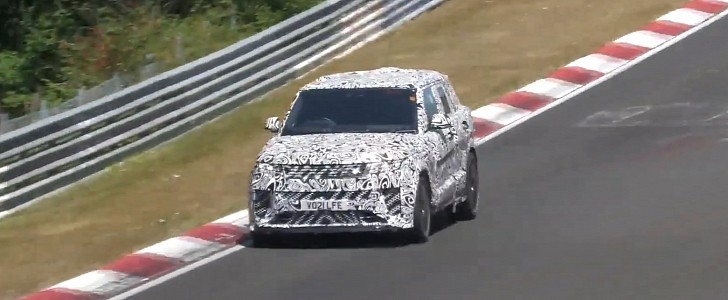The SVR badge is exclusively applied to Land Rover’s most powerful SUVs. The Range Rover Sport SVR came into being eight years ago during the 2014 Moscow International Auto Show, packing a supercharged V8.
A direct-injected supercharged V8 that traces its roots back to the 1990s, that is. Originally rated at 550 ps (542 horsepower) and 680 Nm (502 pound-foot) of torque, the 5.0-liter mill enabled a top speed of 260 kph (162 mph). Sprinting from zero to 100 kph (62 mph) takes only 4.7 seconds.
Land Rover updated the previous-generation Range Rover Sport SVR in 2017 for the 2018 model year with 575 ps (567 horsepower) and 700 Nm (516 pound-foot). Although the top speed matches that of the pre-facelift variant, the zero-to-100-kph sprint improved by two-tenths of a second.
A ground-up redesign of the RRS followed suit, and the 2023 model doesn’t feature a supercharged V8 option. After what appears to be eons, Land Rover has finally confirmed the arrival of a BMW-sourced V8 in the guise of the P530, named as such after petrol (gasoline) and the metric output.
Shared with the full-size Range Rover, the P530 in the Range Rover Sport is another way of saying 530 ps (523 horsepower) and 750 Nm (553 pound-feet) of torque. Land Rover quotes 4.5 seconds, just like its predecessor, but something else is amiss here. Land Rover didn’t use SVR in conjunction with P530, which is only natural considering that the best is yet to come.
Spied looking planted at the world’s most difficult racing circuit, the RRS SVR is expected to launch for the 2024 model year with BMW’s familiar V8 engine. The big question is, what BMW V8 is hiding under the hood?
The N63 in the RRS P530 perfectly matches the peak output figures of the X7 M60i, and there’s no higher specification available at press time. Alternatively, the British automaker may have convinced BMW into selling the N63-based S63 developed by the M division. The most powerful S63 is the one used in the superb M5 CS, which is rated at 635 ps (626 horsepower).
BMW is currently developing a brand-new M5 with the S68 hybridized V8 engine of the XM, making the ICE-only S63 feasible for this application.
Land Rover updated the previous-generation Range Rover Sport SVR in 2017 for the 2018 model year with 575 ps (567 horsepower) and 700 Nm (516 pound-foot). Although the top speed matches that of the pre-facelift variant, the zero-to-100-kph sprint improved by two-tenths of a second.
A ground-up redesign of the RRS followed suit, and the 2023 model doesn’t feature a supercharged V8 option. After what appears to be eons, Land Rover has finally confirmed the arrival of a BMW-sourced V8 in the guise of the P530, named as such after petrol (gasoline) and the metric output.
Shared with the full-size Range Rover, the P530 in the Range Rover Sport is another way of saying 530 ps (523 horsepower) and 750 Nm (553 pound-feet) of torque. Land Rover quotes 4.5 seconds, just like its predecessor, but something else is amiss here. Land Rover didn’t use SVR in conjunction with P530, which is only natural considering that the best is yet to come.
Spied looking planted at the world’s most difficult racing circuit, the RRS SVR is expected to launch for the 2024 model year with BMW’s familiar V8 engine. The big question is, what BMW V8 is hiding under the hood?
The N63 in the RRS P530 perfectly matches the peak output figures of the X7 M60i, and there’s no higher specification available at press time. Alternatively, the British automaker may have convinced BMW into selling the N63-based S63 developed by the M division. The most powerful S63 is the one used in the superb M5 CS, which is rated at 635 ps (626 horsepower).
BMW is currently developing a brand-new M5 with the S68 hybridized V8 engine of the XM, making the ICE-only S63 feasible for this application.








































